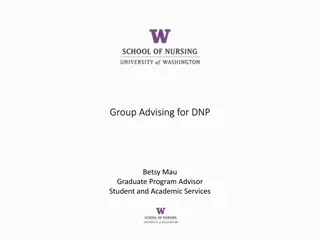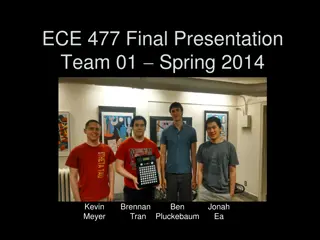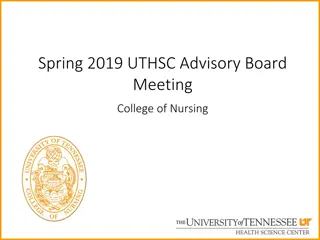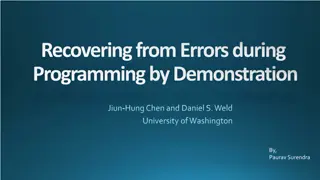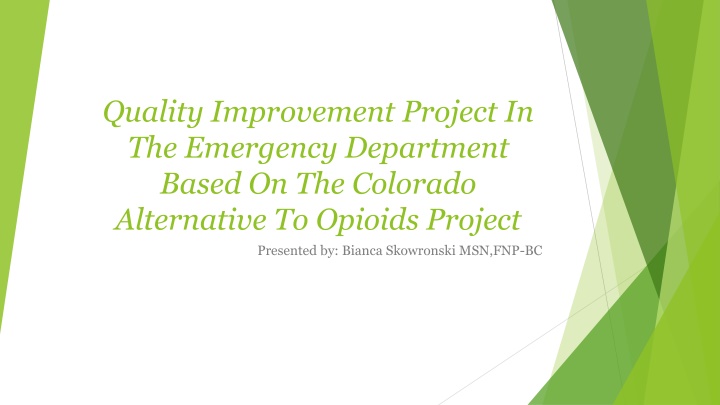
Improving Acute Pain Management in Emergency Departments: Colorado ALTO Project Insights
Explore a quality improvement project focusing on alternative pain management strategies to combat opioid overdose deaths. Learn about the Colorado ALTO Project's success, the implementation template, and a tailored educational intervention for ED staff. Dive into a literature review highlighting key themes and research findings on opioids and acute pain treatment.
Download Presentation

Please find below an Image/Link to download the presentation.
The content on the website is provided AS IS for your information and personal use only. It may not be sold, licensed, or shared on other websites without obtaining consent from the author. If you encounter any issues during the download, it is possible that the publisher has removed the file from their server.
You are allowed to download the files provided on this website for personal or commercial use, subject to the condition that they are used lawfully. All files are the property of their respective owners.
The content on the website is provided AS IS for your information and personal use only. It may not be sold, licensed, or shared on other websites without obtaining consent from the author.
E N D
Presentation Transcript
Quality Improvement Project In The Emergency Department Based On The Colorado Alternative To Opioids Project Presented by: Bianca Skowronski MSN,FNP-BC
Introduction According to the Centers for Disease Control and Prevention (CDC), (2018) in 2017, 70,000 drug overdose deaths occurred in the United States of which 68% of those deaths were from prescription opioids (p.1). Pain Opioid Physicians, dentists, and advanced practice providers Emergency departments (ED)
Background & Significance Fifth vital sign Pharmaceutical companies Prescribing high dose opioids ED overdose visits Strict protocols & policies in place Stealing family members money Alternatives for pain control and prescribe opioids as the last resort.
What is the Colorado ALTO Project? 2017 the Colorado Hospital Association (CHA) and its partners developed the Colorado Opioid Safety Pilot 10 participating sites achieved an average of 36 percent reduction 31.4 percent increase in the administration of alternative to opioids Broken down by chief complaint: renal colic, musculoskeletal pain, chronic abdominal pain, gastroparesis, cyclic vomiting, headache, acute or chronic radicular LBP, and acute fractures.
Template of Colorado ALTO project
Clinical Question Will providing an educational intervention tool based on the quality improvement Colorado ALTO project, to the emergency department staff at Detroit Receiving Hospital (DRH) increase their knowledge and show an interest in implementing the Colorado ALTO project for the management of acute pain in the DRH ED?
Literature Review DATABASE: PubMed, CINAHL, Cochrane, Medline through University of Detroit Mercy Library Database LITERATURE REVIEW RESULTS: Over 500 articles, eight articles utilized in literature review INCLUSION/EXCLUSION: English, full text, dated within 5 years included in literature review. Articles that were non-English, not available for full text (without payment or membership) or dated over 10 years old excluded COMMON THEMES: Alternative treatment options, acute pain, emergency department treatment options, personal prescribing practices, decrease opioid epidemic, ALTO programs KEY WORDS USED: Opioids, emergency department, prescribing, acute pain, ALTO, opioid epidemic, ED health care providers
Project Purpose It has been proven that implementing an ALTO program in the emergency department has shown a reduction in the administration of opioids and an increase in the administration of alternatives to opioids (Colorado ALTO Project, 2019). The purpose is to complete the educational phase of the Colorado ALTO project at DRH s ED by leading providers through an evidence-based educational intervention promoting non-opioid acute pain management strategies and to decrease opioid prescribing and gain buy- in for future implementation.
Theoretical Framework utilizing the Plan-Do-Study- Model for Improvement Act cycle
STRENGTHS WEAKNESS Internal team and expertise (Research committee at DRH s Emergency Department) Resources (personal, UDM, DMC) Geographic advantage Chronic Pain Policy Sickle Cell Policy Thirty-minute Analgesic Administration No formal acute pain protocol / policy for the management of acute pain in the Emergency Departments Extensive monitoring (moving patients) Cost Education / preference on prescribing Patient s Medical History Legal/liability implications Readmission SWOT Analysis OPPORTUNITIES THREATS Partnerships with other hospitals (Detroit Receiving, Harper / Sinai Grace / Children s / Huron Valley Hospital) Need for product in hospitals, particularly ER Support from Emergency Attending s, Residents, Physician Assistants, Nurse Practitioners and Pharmacists. Increasing patient satisfaction scores Reducing the exposure to opioids Safer/more effective patient care Funding: Grant/Investment Health system competitors implementing new protocols Not being up to date on the latest research Recognition
Methods DRH prescribing practices (February of 2020) Personal prescribing practices pre survey (Survey Monkey) Educational intervention (February 19th 2021 @ 8:00am) DRH prescribing practices post educational intervention (February 20th 2021 March 20th 2021) Personal prescribing practices post survey (Survey Monkey)
DRH Prescribing Practices from February of 2020 Specific ICD 10 codes based on diagnosis and chief complaint: N20.0 (Renal colic) & R10.9 (Flank pain), 10.9, Unspecified abdominal pain, K 31.84 (Gastroparesis), R11.15 (Cyclic vomiting), R11.2 (Nausea and vomiting), R51 (Headache), G43.909 (Migraine), M54.5 (Low back pain), M79.1 (Muscle pain), M54.16 (Acute or chronic radicular LBP), M79.601 / M79. 602 (Arm pain), M79.606 (Leg pain), M25.559 (Hip pain), M79.64 (Finger pain), M79.64 (Hand pain), M25.539 (Wrist pain), M25.529 (Elbow pain), M25.519 (Shoulder pain), M25.569 (Knee pain), M25.579, M25.579 (Ankle pain), M79.673 (Foot pain), M79.676 (Toe pain) Age(s): 18-65 Medications used based on chief complaint and diagnosis: Only opioid specific medications used in the ED: Codeine, Fentanyl (Actiq, Duragesic, Fentora, Abstral, Onsolis), Hydrocodone & Acetminophen (Lorcet, Norco, Vicodin), Hydromorphone (Dilaudid), Demerol, Methadone, Morphine, Oxycodone (OxyContin), Oxycodone & Acetaminophen (Percocet) & Tramadol
DRH Prescribing Practices from February of 2020
Personal Prescribing Practices Pre Survey Circle the percentage group that applies to your OPIATE prescribing practices in the ED based on the chief complaints listed below: Renal Colic: 0-25% / 26%-50% / 51%-75% / 76%-100% Headache: 0-25% / 26%-50% / 51%-75% / 76%-100% Musculoskeletal pain: 0-25% / 26%-50% / 51%-75% / 76%-100% Acute and Chronic Radicular Lower Back Pain: 0-25% / 26%-50% / 51%-75% / 76%- 100% Chronic abdominal pain gastroparesis, cyclic vomiting: 0-25% / 26%-50% / 51%- 75% / 76%-100%
DRH Personal Prescribing Practices DRH emergency department has seventy-eight healthcare providers, specifically seventy-five attending physicians, two physician assistants and one nurse practitioner. Of the seventy- eight healthcare providers that are employed thirty- four health care providers completed the pre survey. Based on the questions asked, most health care providers at DRH prescribe between 0 to 50% opioids for the management of renal colic, headache, musculoskeletal pain, acute and chronic radicular lower back pain, chronic abdominal pain, gastroporesis, and cyclic vomiting.
DRH Personal Prescribing Practices DRH Personal Prescribing Practices 35 30 25 20 15 10 5 0 Renal Colic Headache Musculoskeletal Pain Acute and Chronic Radicular LBP Chronic Abdominal Pain, Gastroparesis, & Cyclic Vomiting 0-25% 26%-50% 51%-75% 76%-100%
Educational intervention (February 19th 2021 @ 8:00am)
DRH Prescribing Practices from February 20th 2021 March 20th 2021
Personal Prescribing Practices Post Survey After listening to the presentation based on the Colorado ALTO project did the presentation increase knowledge on the topics discussed?: Please select YES or NO Yes or No After listening to the presentation based on the Colorado ALTO project what is the likeliness to implement the ALTO project into practice: Please circle either NOT LIKELY, SOMEWHAT LIKELY, or VERY LIKELY Not Likely / Somewhat Likely / Very Likely
Personal Prescribing Practices Post Survey Fourteen health care providers responded of which majority of the health care providers said the educational intervention increased their knowledge on the topics discussed (85.71%).
Personal Prescribing Practices Post Survey Fourteen health care providers responded showed that 100% of respondents were either in favor of somewhat likely or very likely to implement the Colorado ALTO project into practice. No respondents responded not likely .
Limitations Covid-19 Pandemic Patient s waiting in the lobby for long periods of time Focused on the early initial phase of implementation The Colorado ALTO project was not fully implemented
Clinical Question Answered Providing an educational presentation based on the quality improvement Colorado ALTO project, did increase the knowledge for the staff at DRH. The educational tool showed interest from the staff with the intent of implementing the Colorado ALTO project for the management of acute pain in the ED.
Recommendation & Dissemination Fully implement the Colorado ALTO project into practice Educating the seventy- eight ED healthcare providers at DRH but will also educate the other ED health care providers at the various other DMC ED s including, Huron Valley, Harper Hospital, Sinai Grace and Children s Hospital of Michigan. Following the completion of the fully implemented Colorado ALTO project into practice, the results will be disseminated through a peer-reviewed nursing journals in order to educate and broaden healthcare providers prescribing practices for the management of acute pain.
Impact and Sustainability Personal impact in my own practice The Colorado ALTO project will be the FIRST ALTO project to be implemented at the DMC in Detroit, MI. Advertisement to future patients Up to date on the current knowledge
Acknowledgements Special Thanks to... Jennifer Ruel DNP, APRN, FNP-BC, ENP-BC, project chair from University of Detroit Mercy. Thank you SO much for your guidance and commitment to this project. I am very fortunate to have had the opportunity to have you has a professor and role model through my academic career over the last 4 years. James Paxton MD,MBA, FACEP FAHA, organizational chair and director of clinical research at DRH. Thank you for giving me the opportunity to perform this project and make a difference and play an impact to the ED healthcare providers at DRH. Thank you to all the staff and DNP faculty at University of Detroit Mercy. It has been a privilege and amazing experience to work with all of you. Lastly, I would like to extend my sincere thanks to my loving parents Dr. Raymond and Mary Ann Skowronski, siblings Deanna and Raymond Skowronski, and boyfriend Nicholas Goza for all their love and support. Without their tremendous understanding, encouragement, and love over the past few years it would have been impossible for me to complete this doctoral project.
References Brooks, D. (2016). Innovative program targets five common pain syndromes with non-opioid alternatives. ED Management , 28(6), 61 72. Retrieved from http://web.b.ebscohost.com.ezproxy.libraries.udmercy.edu/ehost/pdfviewer/pdfviewer?vi d=1&sid=0766aa75-e107-41a9-baad-781027675211@pdc-v-sessmgr06 Center for Disease Control and Prevention. (2019): Opioid overdose: Retrieved from http://www.cdc.gov/drugoverdose/data/index.html Chang, A. K., Bijur, P. E., Esses, D., Barnaby, D. P., & Baer, J. (2017, November 7). Effect of a single dose of oral opioid and nonopioid analgesics on acute extremity pain in the emergency department: A Randomized Clinical Trial. Retrieved from http://www.ncbi.nlm.nih.gov/pubmed/29114833 Cleveland Clinic. (2017). Acute pain vs. chronic pain: What it is & differences. Retrieved from https://my.clevelandclinic.org/health/articles/12051-acute-vs-chronic-pain Colorado ALTO Project. (2019.). Retrieved from https://cha.com/opioid-safety/colorado-alto- project/ Gratton, M. (2017). The ER doctor's role in combating the opioid epidemic. Retrieved from https://www.ncbi.nlm.nih.gov/pmc/articles/PMC6140208/
References Hoppe, J. A., Kim, H., & Heard, K. (2015, May). Association of emergency department opioid initiation with recurrent opioid use. Retrieved from https://www.ncbi.nlm.nih.gov/pubmed/25534654. IHI (2021) :Science of improvement: How to improve: Retrieved March 01, 2021, from http://www.ihi.org/resources/Pages/HowtoImprove/ScienceofImprovementHowtoImprove. aspx Karlow, N., Schlaepfer, C. H., Stoll, C. R., Doering, M., Carpenter, C. R., Colditz, G. A., . . . Schwarz, E. S. (2018, October). A systematic review and meta-analysis of ketamine as an alternative to opioids for acute pain in the emergency department. Retrieved from https://www.ncbi.nlm.nih.gov/pubmed/30019434 Kumar, K, and P Elavarasi. Definition of pain and classification of pain disorders. Journal of Advanced Clinical & Research Insights3 (2016.): 87 90. http://jcri.net/eJournals/_ejournals/112_Review Article.pdf. LaPietra, A., Motov, & Rosenberg. (2016). Alternatives to opioids for acute pain management in the emergency department: Part I. ProQuest, 37(19). Retrieved from https://search- proquestcom.ezproxy.libraries.udmercy.edu/docview/1993224917/fulltext/BF8C7B84A7 DD4248PQ/1?accountid=28018
References NIH. 2019. The drug overdose epidemic affects all U.S. communities. Retrieved from https://nimhd.nih.gov/news-events/features/community-health/overdose-epidemic.html Scalpel, S. (2016). The Joint Commission deserves some blame for the opioid crisis. Retrieved from https://www.ncbi.nlm.nih.gov/pmc/articles/PMC6139759/ Todd, K. H. (2017, December). A review of current and emerging approaches to pain management in the emergency department. Retrieved from https://www.ncbi.nlm.nih.gov/pmc/articles/PMC5693816/.













